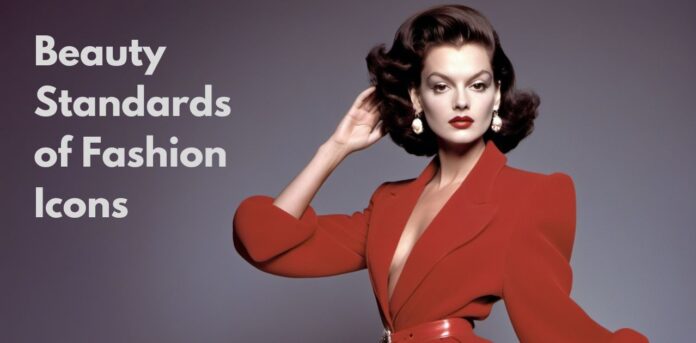From the 1800s through today, popular culture and fashion icons have remarkably shifted society’s beauty standards and body ideals. Each generation has its contrasting physiques in vogue, illustrating how these standards constantly flux. By looking back at how fashion trends and iconic figures have molded mainstream beauty concepts over time, we reveal the striking evolution of an ever-changing cultural yardstick.
The Nineteenth Century’s Voluptuous Valor
In the early 1800s, beauty was defined by a full-figured, womanly shape achieved by tightly laced corsets. Portrait paintings from this era feature women with tiny waists and ample bosom and hips. Terms like voluptuous and Rubenesque were compliments referring to the desirable hourglass shape.
Fashion icon Lillian Russell represented the pinnacle of beauty standards in her day. The popular singer, dancer, and stage actress weighed nearly 200 pounds at the height of her fame. Her curves were synonymous with femininity, good health, and affluence at the turn of the century.
“I have never dieted in my life. I weigh myself before breakfast each morning and eat accordingly.” (Lillian Russell)
Women laced dangerously tight corsets and even ate chalk or drank vinegar to appear pale and fragile, as that too was considered beautiful. But Lillian Russell’s shining confidence in her curvaceous, larger-than-life figure paved the way for shifting perspectives.
Flattening the Curve: The Roaring 20s
The 1920s roared in an abrupt cultural 180, popularizing a straight, curveless physique. Binding breast tissue became fashionable as the flapper dress trend rejected the exaggerated hourglass shape. Fashion icons like Josephine Baker and film star Clara Bow modeled this bold, androgynous style with bobbed hair and shapeless lines.
Designers like Coco Chanel created loose, waistless frocks allowing women to move freely and embrace sporty, leisure activities. The lush curves iconic just decades before were now viewed as old-fashioned. This shift liberated women aesthetically but revealed the immense influence fashion wields over beauty notions.
The flapper look popularized in the 1920s discarded the Victorian hourglass ideal of years past.
Back to Bombshells (Hollywood’s Golden Age)
Just as quickly as flattened forms came into vogue, the 1930s and 1940s returned to celebrating curves through its iconic Hollywood starlets. Leggy dancers Betty Grable and Rita Hayworth became famous WWII pin-ups. Symbolized by her signature swimsuit pose, Marilyn Monroe defined feminine beauty with her platinum curls, full lips, and buxom bust. And bombshell Jayne Mansfield unabashedly flaunted her exaggerated dimensions.
In contrast, gamine Audrey Hepburn increased appeal for angular bone structure and a waif-like thinness. As Hollywood attracted global admiration, these stunning but contrasting icons influenced popular beauty concepts through decades of idolization on and off screen. Their lasting impact reminds us that accepted beauty standards vary depending on an era’s admiration.
Sizing Down: Sixties’ Twiggy Phenomenon
The 1960s introduced Twiggy Lesley Lawson, whose towering height yet alarmingly slight 92-pound frame remains an almost unbelievable beauty standard decades later. With wide eyes, pixie haircut and stick legs, her look is credited for shifting fashion’s focus starkly from curvy to lean.
“Twiggy” Lesley Lawson’s remarkably slim physique transformed beauty concepts in the 1960s.
Twiggy reflected flourishing youth culture while bringing modeling mainstream with covers of fashion and lifestyle magazines. She represented fashion’s pivot towards celebrating angular, androgynous bodies over feminine muscle. To achieve this shape, unhealthy habits became implicit norm.
Heroin Chic: Glamorizing Alarming Standards
The controversy of unhealthy “thinspiration” escalated dangerously in the early 1990s with fashion’s embrace of “heroin chic”. Kate Moss’s grim-faced ads leveraged her hollow cheeks, protruding bones and pallid skin to evoke life on the streets. She followed the trend of waifish models like Claudia Schiffer dominating runways and magazines. Critics denounced the fashion industry for so explicitly glamorizing alarming standards linked to life-threatening drug addiction.
As models thinned to skeletal proportions, a 1997 Time article called Kate Moss the “postergirl” for “to-die-for” standards promoting disorderly conduct.
The VisualMD site owned by Interest Fashions estimates up to 30,000 US women died from anorexia-related disorders that decade alone. This reveals a theme fashion critics contend still today – the industry’s gatekeeping of beauty notions carry dangerous influence over women’s self-worth and health.
Fitness Meets Fashion: Embracing “Strong is the New Skinny”
Luckily, recent decades moved towards embracing more realistic, healthy ideals. Athletic builds surged in popularity as yoga pants became everyday wear. Celebrities like model Gigi Hadid showcase toned abs and muscular legs rather than protruding bones. High fashion brands expanded lines to include training and sportswear. And icons like Serena Williams adorned the 2019 Pirelli calendar as symbols of grace, talent and feminine power.
This cultural shift towards celebrating fitness rejects fashion’s previous notion that visible strength detracts femininity or beauty. Hashtags like “Strong is the New Skinny” attempt to recondition perspectives not solely focused on thinness. Though runway model stats remain below healthy body mass standards, there is gradual improvement in embracing more size diversity and combatting unhealthy messaging.
Key Facts
- For nearly two centuries tight corsets painfully altered women’s bodies to achieve a desirable hourglass shape
- Flapper culture in the 1920s popularized breast binding and shapeless lines, contrasting dramatic curves iconic just years before
- Curvy 1950’s starlets like Marilyn Monroe defined beauty in cinema’s Golden Age
- Twiggy’s incredible slimness made thinness an aspirational standard in the 1960s
- 1990’s “heroin chic” sparked immense controversy for glamorizing alarming habits
- Recently, increased fitness culture expanded beauty concepts beyond just thinness
These major shifts reveal western beauty concepts constantly change form decade to decade as icons influence popular perspectives. Recognizing the past’s influence helps put current standards into perspective.
Beauty Takes Many Forms
The flux of varying body types deemed beautiful over 200 years confirms beauty’s subjectivity throughout history. As times change, so do the yardsticks society measures beauty by.
Rather than narrowly glorify imagery harmfully impacting women’s health and self-image, we must thoughtfully challenge fashion’s gatekeeping of beauty notions. Choosing positive role models and messaging instead continues momentum toward realistic standards focused beyond thinness alone.
Progress starts from within. The most empowering act remains learning self-acceptance no matter how our bodies change shape over time.
FAQ’s
How has beauty changed over time?
Beauty standards have undergone major shifts from hourglass figures in the 1800s to flappers in the ‘20s, bombshells in the ‘50s, Twiggy’s thinness in the ‘60s, “heroin chic” in the ‘90s and athletic builds today.
How have mainstream standards of feminine beauty changed over the last century?
The feminine beauty ideal drastically turned from curvy corseted bodies to flat flappers in the 1920s, hourglass bombshells like Marilyn Monroe in the 1950s, very thin models such as Twiggy in the 1960s to athletically toned bodies today.
How have body standards changed over time?
Women’s body standards went from tiny cinched waists in the 1800s to flat-chested flappers in the 1920s to voluptuous Hollywood bombshells then rail-thin models like Twiggy before alarmingly thin “heroin chic” gave way to fit, toned bodies.
What were the beauty standards in ancient times?
Ancient Greek/Egyptian beauty prized angular jaws, full lips, almond-shaped bold eyes, facial symmetry and proportion. Goddess figures had exaggerated hips/thighs. The Renaissance saw fair hair, scalloped collarbones and ample cleavage as ideal.


